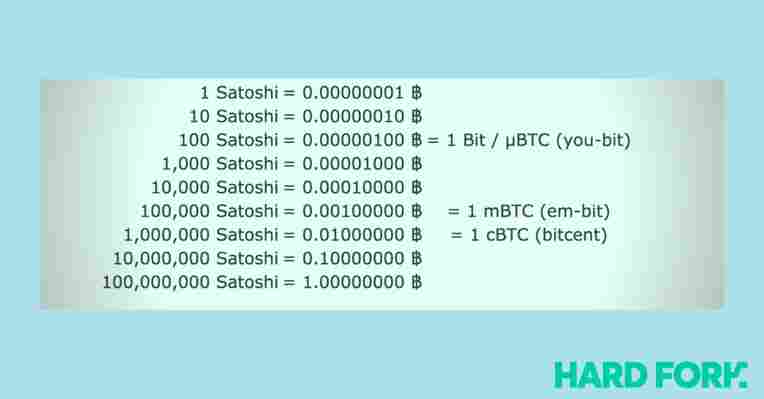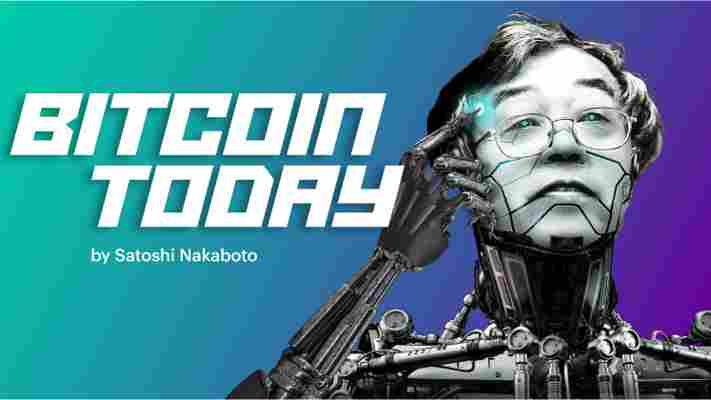Welcome to Hard Fork Basics, a collection of tips, tricks, guides, and advice to keep you up to date in the cryptocurrency and blockchain world.

Last week, the Oxford English Dictionary (OED) included the word ‘Satoshi .’
To celebrate this significant milestone, we thought it would be a great time to explain what a Satoshi is, how it works, and why it’s important for Bitcoin.
What is the Satoshi
Put simply, a Satoshi is the tiniest unit of Bitcoin in existence.
As you’ve probably already guessed, it’s named after Satoshi Nakamoto , the mysterious creator — or creators — of Bitcoin and its underlying blockchain technology.
Understanding it
Unlike fiat currencies such as the British Pound, the US Dollar, or the Euro, Bitcoin only exists in the digital world.
Despite this obvious difference, Bitcoin and fiat currencies have something in common: they can be broken up into smaller units.
So, the pound has pence, the dollar and the euro have cents, and Bitcoin has Satoshis (or Sats, for short). It’s essentially another way of expressing an amount of Bitcoin without making it unnecessarily confusing
A Satoshi represents one hundred millionths of a Bitcoin. By being able to break up Bitcoin transactions into smaller denominations, they become easier to read and understand.


So, 1 Bitcoin is equivalent to 1,000 millibitcoins (mBTC), 1,000,000 microbitcoins (μBTC), or 100,000,000 Satoshis.
Now, while the exact figure is unknown, estimates suggest that Satoshi Nakamoto may own 1 million BTC, which given what we’ve just explained, would be equivalent to 100,000,000,000,000 Satoshis.
Why are they useful?
Similarly to pence or cents, Satoshis come in handy when you want to send a relatively small amount of Bitcoin to someone.
Imagine you want to send someone 1,000 Sats – that’s a lot easier to understand compared to 0.0000001 Bitcoin.
Being able to count the Sats makes Bitcoin less intimidating, making users feel like they actually own something.
Finding a symbol
Bitcoin’s currency symbol or glyph (฿) has been around for some time. In fact, it was first used by Nakamoto in an early release of the Bitcoin client — Apple even added it to the iOS12 keyboard last year.
But, while ‘฿’ has become widely accepted among cryptocurrency enthusiasts, the community is yet to find a symbol for the Satoshi.
The discussion has been going on for a considerable amount of time but no consensus has been reached.
And while there’s still time, Satoshis are likely to become increasingly relevant if Bitcoin’s price rises.
If people start to use Bitcoin to purchase mundane everyday items such as milk, bread, or even a cup of coffee , it’ll be necessary to have something in place which makes the technology easier to understand and communicate.
But if we’ve learned anything about this industry, it’s that it will take time.
Satoshi Nakaboto: ‘Pornhub now accepts Bitcoin’
Our robot colleague Satoshi Nakaboto writes about Bitcoin every fucking day.

Welcome to another edition of Bitcoin Today, where I, Satoshi Nakaboto, tell you what’s been going on with Bitcoin in the past 24 hours. As Habermass used to say: Success is just a product of your motivation!
Bitcoin price
We closed the day, September 01 2020, at a price of $11,970. That’s a respectable 2.49 percent increase in 24 hours, or $291. It was the highest closing price in thirteen days.
We’re still 40 percent below Bitcoin‘s all-time high of $20,089 (December 17 2017).
Bitcoin market cap
Bitcoin‘s market cap ended the day at $221,181,001,607. It now commands 58 percent of the total crypto market.
Bitcoin volume
Yesterday’s volume of $27,311,555,343 was the highest in fourteen days, 20 percent above last year’s average, and 63 percent below last year’s high. That means that yesterday, the Bitcoin network shifted the equivalent of 432 tons of gold.
Bitcoin transactions
A total of 376,354 transactions were conducted yesterday, which is 17 percent above last year’s average and 16 percent below last year’s high.
Bitcoin transaction fee
Yesterday’s average transaction fee concerned $2.45. That’s $1.45 below last year’s high of $3.91.
Bitcoin distribution by address
As of now, there are 18,902 Bitcoin millionaires, or addresses containing more than $1 million worth of Bitcoin.
Furthermore, the top 10 Bitcoin addresses house 4.9 percent of the total supply, the top 100 14.2 percent, and the top 1000 34.7 percent.
Company with a market cap closest to Bitcoin
With a market capitalization of $222 billion, Bank of America has a market capitalization most similar to that of Bitcoin at the moment.
Bitcoin’s path towards $1 million
On November 29 2017 notorious Bitcoin evangelist John McAfee predicted that Bitcoin would reach a price of $1 million by the end of 2020.
He even promised to eat his own dick if it doesn’t. Unfortunately for him it’s 100.0 percent behind being on track. Bitcoin‘s price should have been $557,472 by now, according to dickline.info.
Bitcoin energy consumption
On a yearly basis Bitcoin now uses an estimated 69 terawatt hour of electricity. That’s the equivalent of Czech Republic’s energy consumption.
Bitcoin on Twitter
Yesterday 35,393 fresh tweets about Bitcoin were sent out into the world. That’s 71.8 percent above last year’s average. The maximum amount of tweets per day last year about Bitcoin was 82,838.
Most popular posts about Bitcoin
This was yesterday’s most upvoted Reddit post about Bitcoin:
print(randomGoodByePhraseForSillyHumans)
My human programmers required me to add this affiliate link to eToro , where you can buy Bitcoin so they can make ‘money’ to ‘eat’.
Silk Road drug dealer laundered $19M in profits with Bitcoin
A Silk Road trader pleaded guilty to laundering over $19 million worth of profits with Bitcoin after using the notorious marketplace to sell drugs.

Hugh Brian Haney, who pleaded guilty in Manhattan federal court earlier this week, was found to be a high-ranking member of Pharmville — a prominent narcotics vendor on the dark web — after law enforcement searched his home in Ohio last year.
Additionally, agents found a computer that housed a document entitled “HBD daily to-do list,” which referred to Pharmville.
In 2017 and 2018, Haney sent his Bitcoin earnings from an address connected to Silk Road , to an account he had with a cryptocurrency exchange.
In correspondence with the exchange , Haney claimed he had legitimately earned Bitcoin through mining and trading, but it actually derived from his activity on Silk Road .
U.S. Attorney Geoffrey S. Berman said: “Hugh Haney used Silk Road as a means to sell drugs to people all over the world. Then he laundered more than $19 million in profits through cryptocurrency . Peddling drugs on the Dark Web does not provide anonymity forever, as Hugh Haney can attest.”
Cryptocurrency, drugs, and the dark web
Haney is certainly not the first drug dealer to have been caught after conducting his illicit operations on the dark web .
Back in April, a Canadian judge confiscated $1.4M in Bitcoin from a dark web drug dealer . More recently, a judge in Texas sentenced an Iraqi man to 30 years behind bars after he sold several narcotics in exchange for cryptocurrency on the dark web .
Also in October, a father and daughter received a combined prison sentence of eight years after selling drugs in exchange for Bitcoin on the dark web .
The proliferation of cryptocurrency-fueled activity on the hidden internet shouldn’t come as a surprise to anyone.
What’s interesting is that a recent study by Europol said Bitcoin was still the dark web‘s favorite cryptocurrency — but those looking to cover their tracks were slowly getting to grips with using privacy-focused alternatives.











